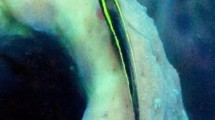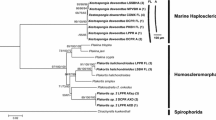Abstract
Samples from populations of a common Red Sea coral reef sponge, Mycale fistulifera, contained 1.7 to 25% sponges associated with polyps of Nausithoë cf. punctata Kölliker, 1853 (Scyphozoa: order Coronata). In the northern Red Sea this colonial scyphozoan was found exclusively in symbiosis with sponges. The proportion of the symbiotic sponges within the population differed significantly between seasons. Polyps were found significantly more frequently on large (>30 cm2) sponges than on small (<30 cm2) ones. The polydisc polyps of N. cf. punctata released ephyrae for 1 to 4 mo during the summer, several days before full moon, mainly during the afternoon and early evening. A colony discharged up to 1340 ephyrae d-1, with variations between colonies and years. During the 13.5 mo of monitoring, symbiotic sponges survived better than aposymbiotic ones (43 versus 3%). Few ephyrae survived in the laboratory until maturity (12% for 30 d). During in situ experiments the starfish Choriaster granulatus avoided symbiotic sponges but fed on aposymbiotic ones. The echinoid Tripneustes gratilla showed a similar trend (although statistically P>0.005), while Diadema setosum fed equally or less (P>0.05) on symbiotic compared with nonsymbiotic sponges. Echinotrix colamaris fed on both symbiotic and nonsymbiotic sponges. This mutual symbiosis seems to be facultative for the sponge and obligatory for the scyphozoan. Some of the demonstrated benefits of this symbiosis are: the sponge enhanced survival, size and relative protection; and the absence of free-living scyphozoans indicates the necessity of the association for the survival of N. cf. punctata.
Similar content being viewed by others
References
Abele LG (1984) Biogeography, colonization and experimental community structure of coral-associated crustanceans. In: Strong DR, Simberloff D, Abele LG, Thistle AB (eds) Ecological communities, conceptual issues and the evidence. Princeton University Press, Princeton, pp 123–137
Bobzin SC, Faulkner DJ (1992) Chemistry and chemical ecology of the Bahamian sponge aplysilla glacialis. J chem Ecol 18: 309–332
Castro P (1988) Animal symbiosis in coral reef communities: a review. Symbioses 5: 161–184
Dayton PK (1971) Competition disturbance, and community organization: the provision and subsequent utilization of space in a rocky intertidal community. Ecol Monogr 41: 351–389
Ilan M, Loya Y (1990) Sexual reproduction and settlement of the coral reef sponge Chalimula sp. from the Red Sea. Mar Biol 105: 25–31
Ilan M, Vacelet J (1993). Kebira uteoides (Porifera, Calcarea). A recent “pharetronid” sponge from coral reefs. Ophelia 38: 107–116
Jackson JBC (1977) Competition on marine hard substrata: the adaptive significance of solitary and colonial strategies. Am Nat 111: 743–767
Jarms G (1991) Taxonomic characters from the polyp tubes of coronate medusae (Scyphozoa, Coronatae). Hydrobiologia 216/217: 463–470
Matsumasa M (1994) Effect of secondary substrate on associated small crustaceans in a brackish lagoon. J exp mar Biol Ecol 176: 245–256
McClintock JB (1987) Investigation of the relationship between invertebrate predation and biochemical composition, energy content, spicule armament and toxicity of benthic sponges at McMurdo Sound, Antarctica. Mar Biol 94: 479–487
Meroz E, Ilan M (1995) Life history characteristics of a coral reef sponge. Mar Biol 124: 443–451
Osman RW, Haugsness JA (1981) Mutualism among sessile invertebrates: a mediator of competition and predation. Science, NY 211: 846–848
Por FD (1978) Lessepsian migration—the influx of Red Sea biota into the Mediterranean by way of the Suez Canal. Ecol Stud 23
Saffo MB (1992) Invertebrates in endosymbiotic associations. Am Zool 32: 557–565
Sarma AS, Daum T, Müller WEG (1993) Secondary metabolites from marine sponges. Ullstein mosby, Berlin
Smith DC, Douglas AE (1987) The biology of symbiosis. Edward Arnold, London
Tanaka J, Higa T, Suwanborirux K, Kokpol U, Bernardinelli G, Fefford CW (1993) Bioactive Norsestertorpene 1,2-Dioxanes from a Thai sponge, Mycale sp.. J org Chem 58: 2999–3002
Uriz MJ, Rosell D, Maldonado M (1992) Parasitism, commensalism or mutualism? The case of Scyphozoa (Coronatae) and horny sponges. Mar Ecol Prog Ser 81: 247–255
Werner B (1979) Coloniality in the Scyphozoa: Cnidaria. In: Larwood G, Rosen BR (eds) Biology and systematics of colonial organisms. Academic Press, London, pp 81–103
Westinga E, Hoetjes PC (1981) The intrasponge fauna of Spheciospongia vesparia (Porifera, Demospongiae) at Curagao and Bonaire Mar Biol 62: 139–150
Author information
Authors and Affiliations
Additional information
Communicated by O. Kinne, Oldendorf/Luhe
Rights and permissions
About this article
Cite this article
Meroz, E., Ilan, M. Cohabitation of a coral reef sponge and a colonial scyphozoan. Marine Biology 124, 453–459 (1995). https://doi.org/10.1007/BF00363919
Received:
Accepted:
Issue Date:
DOI: https://doi.org/10.1007/BF00363919




